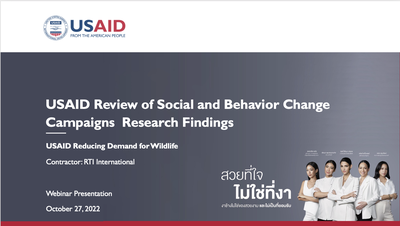USAID Shares Findings from Review of Nine Highly Effective Demand Reduction Campaigns
USAID Wildlife Asia, implemented from 2016 to 2022, pioneered the use of SBCC as an approach to reduce consumer demand making up part of the multibillion-dollar trade in illegal wildlife parts and products. SBCC uses a five-step process based on data-driven approaches and marketing principles to target consumers with tailored messages to influence attitudes and behaviors.
Prior to USAID Wildlife Asia, a situation analysis conducted in 2017 revealed that communication campaigns to reduce demand for wildlife products targeted the general population and resulted in high levels of awareness. However, the conservation messages in those campaigns, which highlighted animal cruelty and endangerment of animal species, did not resonate with individuals who use or would like to use illegal wildlife products. Applying SBCC principles, USAID Wildlife Asia campaigns implemented in China, Thailand, and Vietnam narrowed down the target audience to focus on actual and potential consumers and promoted messaging to counter the drivers underlying their demand for these products. Post-campaign surveys demonstrated that the campaigns succeeded in significantly decreasing intention to purchase and social acceptability of wildlife products among current and likely consumers by an average of 50 percent and 30 percent, respectively.
RDW undertook the review to assess the factors that contributed to the success of these nine campaigns, the challenges faced, actions taken, and lessons learned. The October 27 webinar was an opportunity to share best practices from the highly impactful SBCC campaigns in the three countries and expand the knowledge and application of this methodology.
More than 80 participants attended the webinar from USAID and other U.S. Government agencies, NGOs, and the private sector, globally. A Q&A session followed the presentation of findings, with questions posed on topics such as women’s roles in reducing wildlife demand, challenges faced in selection of messengers, tracking trends in illegal wildlife demand, building a regional SBCC community of practice, and implementing SBCC campaigns in a variety of settings. One participant asked how conservation messages can be crafted to enhance their impact among youth, an emerging market for illegal wildlife products. Ms. Deutsch replied, “This is the great potential in building partnerships with the education sector for example, to really challenge not just with the conservation message, but to go deeper to understand the ways in which these practices are contextualized in day-to-day life. It is also important that we challenge the gender roles that lead to wildlife being purchased or owning wildlife [products] as a status symbol and build on more positive peer/family dynamics. There are many robust examples of programs introduced through the education sector and through community locations where young people can take more ownership of their country’s biodiversity.”
Several participants commented on exploring SBCC methods in their work. Ms. Eleanora DeGuzman, RDW SBCC/Demand Reduction Team Lead, discussed the campaigns’ implementation and how the methodology could be tailored to different contexts and needs. She stressed the importance of monitoring campaign implementation in order to gather data for adaptive management actions. Effective implementation is crucial to the success of campaigns. Sharing knowledge on the effective use of SBCC to reduce demand for wildlife products can improve the success of campaigns, decrease purchases and consumption, and protect endangered wildlife. Ms. Deutsch said, “Globally there is increased attention on the important role social behavior change can play across sectors, and conservationists and governments are also aware that without this concerted effort to really tackle demand, the multi-billion dollar trade of illegal wildlife products will continue to flourish. We know that sustainable solutions are needed to stem the tide in a challenging environment where these consumers are harder to find and the channels for purchase are sometimes hidden.”
Download the Review of USAID Wildlife Asia Social and Behavior Change Communication (SBCC) Campaigns.
Watch a video of the presentation below.


